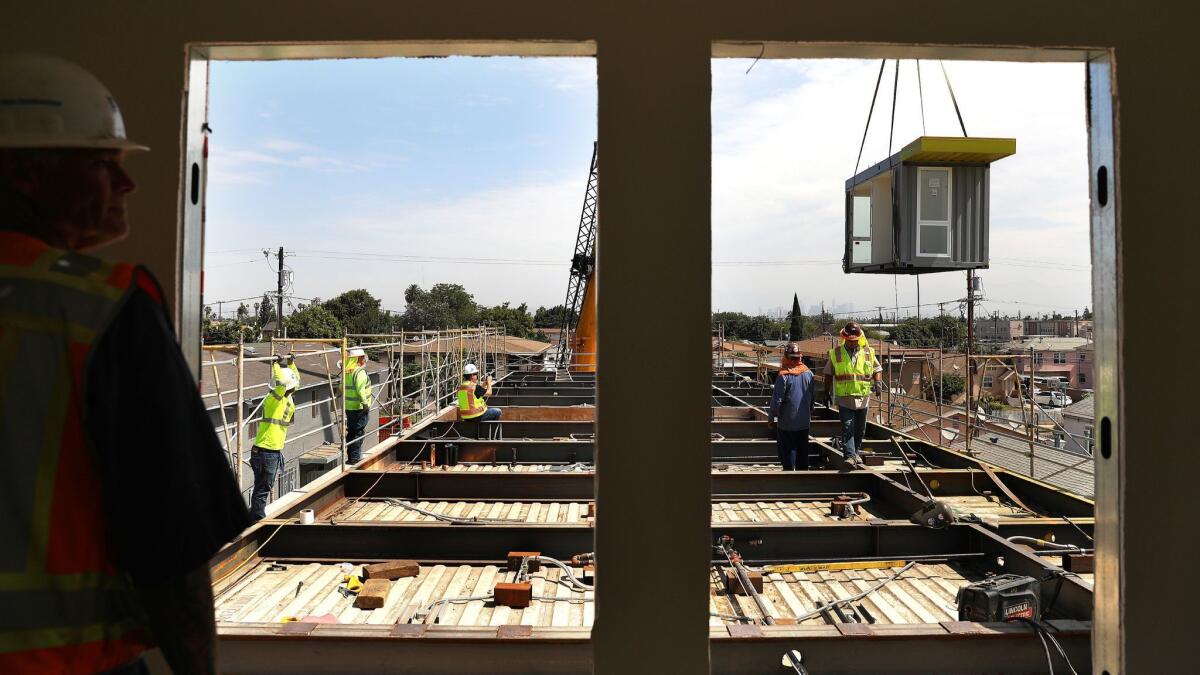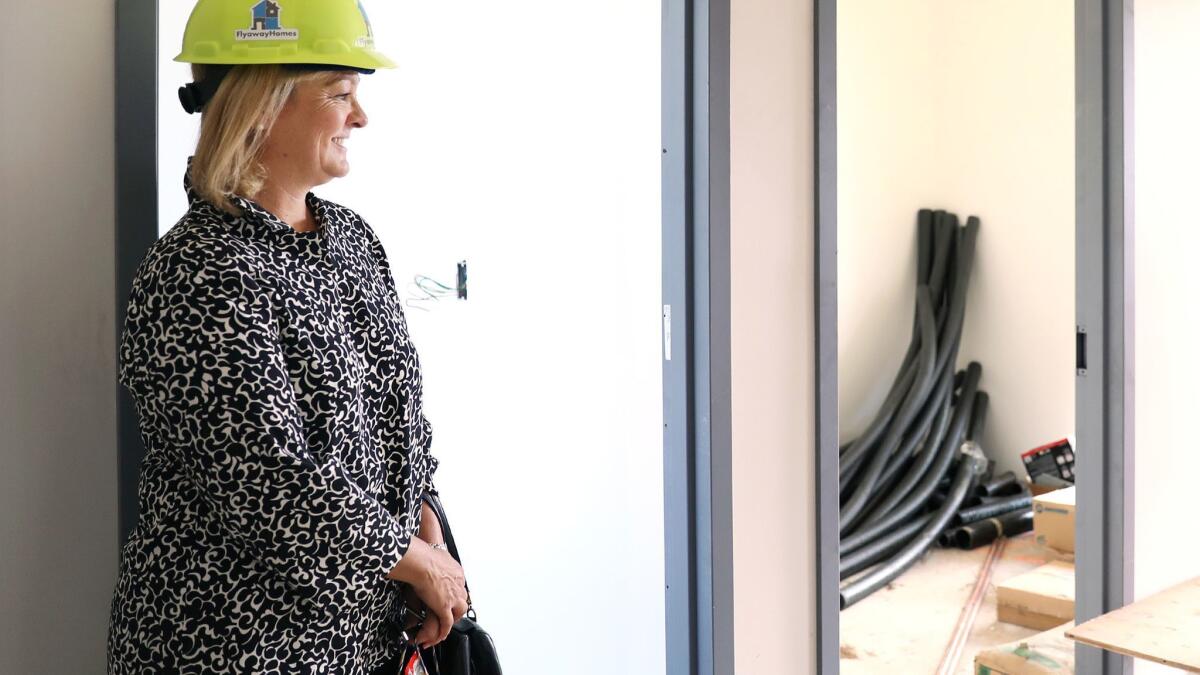Wanted: Innovative ideas to house homeless people faster and at a lower cost

- Share via
By City Hall standards, the proposal was audacious. A developer asked to borrow $64 million from Los Angeles and promised to match it with $16 million raised privately from people who want to invest in good works.
The money would build 60 projects, providing housing for 1,980 homeless people, then be repaid in full three years later with 3% interest.
For members of the citizens committee overseeing spending of the city’s $1.2-billion homeless housing bond, that picture finally seemed like the answer to a question they had asked over and over: How can that housing be built more quickly and for less money?
“I am so excited this is possible,” said committee member Kerry Morrison. “I think this is what the public expects.”
But city officials quickly put the brakes on their enthusiasm.
“That would be extremely challenging,” said assistant City Administrative Officer Yolanda Chavez. “We don’t normally sole-source a project. We’d have to talk to the city attorney. It may have to go through a competition.”
Rising costs threaten housing goal
That exchange in August highlighted the frustration of the committee, which was appointed by Mayor Eric Garcetti after voters approved the Proposition HHH bond measure in 2016.
In the spring, the City Council directed the committee to recommend improvements to the conventional way of building supportive housing projects, which take three to five years and are skyrocketing in cost.
Committee members have pressed city bureaucrats to come up with innovative ideas to speed the pace and curb the costs they see as threats to the Proposition HHH goal of building 10,000 homeless housing units.
“We have an obligation to the voters to not only meet the goals, which right now we’re not going to make, but to bring the cost to a place where it doesn’t sound like we’re building luxury condos,” Morrison said.
Chairman Miguel Santana, the former city administrative officer, has not hesitated to show his dissatisfaction with his former colleagues.
“For the first year, the agenda has been driven by the staff,” Santana said in an interview. “The committee has decided we are going to be proactive in inviting new ideas and approaches.”
Upping the pressure, the committee plans to set aside a portion of next year’s Proposition HHH funds for innovative projects.
Then it reached outside the city bureaucracy for ideas.

A push to reduce delays
Alerted by an article in The Times on an apartment being built for 32 homeless people without public subsidy, the committee invited the developer to its August meeting.
Lawry Meister, president of FlyawayHomes, took the opportunity to propose an alternative to the standard way of funding supportive housing — a process that combines tax credits with other state or local grants and loans and is one of the main causes of the long lead times to construction.
The city, Meister said, should scrap its initial plan of using HHH money to partially fund projects in the hope of leveraging the local money.
Meister argued that the money would go further if loaned to fund 100% of a project, helping it to turn around faster so the money could be quickly recycled.
Meister challenged another assumption of the supportive housing model — that every person needs a separate living unit. At FlyawayHomes’ project in South Los Angeles, four people share each unit with a bedroom for each and common kitchen and living rooms.
The one-unit-per-person requirement “really adds to the cost,” Meister said.
Pressed by Santana, officials of the Housing and Community Investment Department said nothing in the ballot language would stop the city from loaning 100% of a project’s cost. Nor would it prohibit shared housing or private investment with a profit motive.
Other conditions of the proposal proved more troublesome.
The city would need to provide suitably zoned land for the projects in each council district, Meister said, and the requirement to pay a prevailing wage would have to be dropped.
Edwin Gipson, director of the housing department’s development and finance division, agreed to talk to Meister to see if they could reach common ground.
Those talks are still ongoing, but the committee didn’t stop there.
“At each one of the meetings, we’re going to be inviting different innovators to present their recommendations on what we should do,” Santana said.
In Santana’s assessment, the success of Proposition HHH is at stake.
The promise of the measure’s backers for construction of 10,000 units of supportive housing in a decade has teetered under rapidly escalating costs.
Per-unit costs soar to $500,000
The expectation that the housing could be built for as little as $300,000 per unit quickly vanished in a real estate construction boom.
Per-unit costs jumped to $450,000 last year, and the latest round of proposals for 15 projects came in at more than $500,000 per unit, the housing department’s director Rushmore Cervantes, told the committee in September.
At the current rate of spending, the bond money will be exhausted long before 10,000 units are built, city officials conceded earlier this year.
To make up the shortfall, they are counting on other sources of money, particularly the city’s new fee on developments and the No Place Like Home fund the Legislature carved out of mental health programs.
The $2-billion fund is now in jeopardy. Responding to a legal challenge, the Legislature placed the issue on the November ballot for voters to decide.
Even if the money comes through, Santana rejects the suggestion that the commitment to voters who approved Proposition HHH can be met backfilling it with other funds.
“That state revenue, when it comes, should result in even more housing,” he said.
At its September meeting, the committee received presentations by Gensler architects and Clifford Beers Housing that focused on pre-fabricated micro housing, zoning requirements, obstacles to financing and even new social models.
Rob Jernigan, Gensler’s regional managing principal, showed a diagram of a micro-unit project that had 20 tiny sleeping quarters organized around a large common kitchen and living room.
“That’s an important aspect to the cost but also socially,” Jernigan said. “People want this and they can have it, small sleeping quarters, but they share all the other amenities.”
Cristian Ahumada, executive director of nonprofit developer Clifford Beers, offered ideas including long-term leases to remove land costs from capital budgets, removing parking requirements and creating a funding model for small developments.
“Most of L.A. is not higher density,” Ahumada said. “We have zero permanent supportive housing tools to deal with that. I can’t do a 15-unit [tax credit] project. It just won’t pencil.”
Following both presentations, the committee members broke into applause.
The committee is scheduled to hear more ideas at its October meeting, then make recommendations to the City Council in November.
More to Read
Sign up for Essential California
The most important California stories and recommendations in your inbox every morning.
You may occasionally receive promotional content from the Los Angeles Times.










